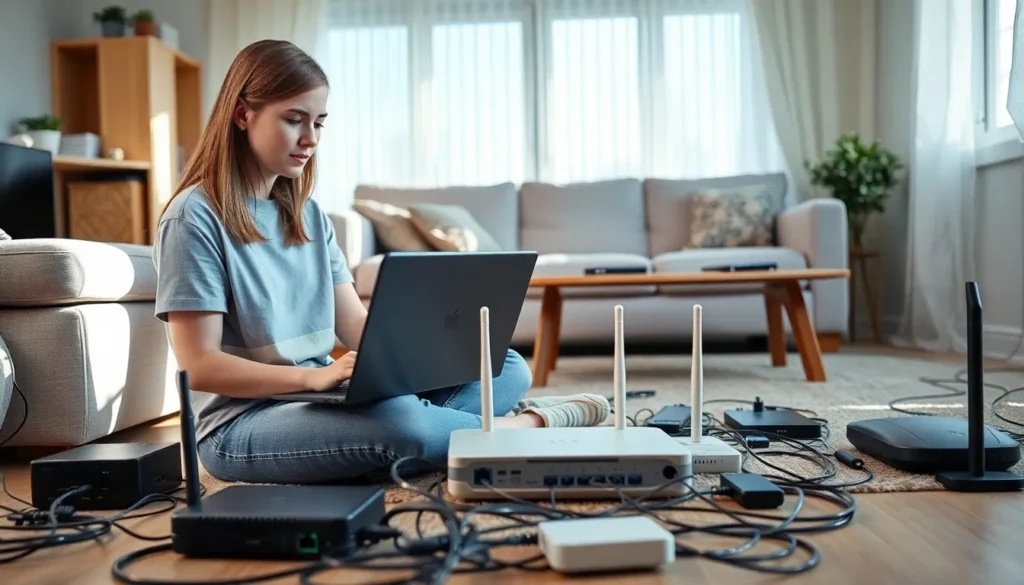In today’s tech-savvy world, a reliable home network is as essential as a good cup of coffee—without it, chaos reigns. Whether it’s streaming the latest binge-worthy series or trying to work from home without those pesky buffering issues, a solid network can make or break the experience. But fear not! Setting up a home network doesn’t require a degree in rocket science or a PhD in IT.
Table of Contents
ToggleUnderstanding Home Networking
Home networking includes all devices connected to the internet within a home. This setup allows seamless connectivity for various activities, from browsing to streaming.
What Is Home Networking?
Home networking refers to the combination of hardware and software that connects multiple devices in a household. Routers, switches, and access points serve as key components in this system. Devices like smartphones, computers, and smart TVs communicate over this network. Each device can share resources, such as printers and files, enhancing overall productivity and convenience.
Benefits of Home Networking
Home networking offers numerous advantages. First, it provides reliable internet access across multiple devices. Second, multiple users can connect simultaneously without compromising speed. Increased control over data usage enables efficient management of bandwidth for streaming or gaming. Secure connections protect sensitive information from unauthorized access. Home networking enhances streaming quality, making it ideal for multiple viewers. Overall, it fosters a connected lifestyle that meets modern demands.
Components of a Home Network

Understanding the components of a home network is vital for effective setup and connectivity. These devices work together to ensure seamless internet access and communication among household devices.
Modems and Routers
Modems serve as the bridge between the internet and the home network. They convert incoming data from the service provider into a format usable by network devices. Routers distribute this data to multiple devices, ensuring that computers, smartphones, and smart TVs connect effectively. Many modern devices combine modems and routers into one unit for improved efficiency. For households with high internet usage, choosing a modem and router combo with advanced features can enhance overall performance.
Network Switches and Access Points
Network switches expand connectivity within a home network. They connect multiple devices directly through Ethernet cables, facilitating reliable communication. Access points extend wireless coverage to areas where signal strength may be weak. They allow for additional devices to connect wirelessly without hindering network speed. Utilizing both switches and access points can optimize network performance, especially in larger homes where distance impacts connectivity. Incorporating these components ensures a robust and efficient home network setup.
Setting Up a Home Network
Setting up a home network requires thoughtful planning and execution to ensure optimal performance. Key steps involve understanding layout and effectively connecting devices.
Planning Your Network Layout
Begin by assessing the size of the home and the locations of devices needing internet access. Identify areas with strong signal strength for routers and access points. Consider multiple floors or rooms, as larger homes benefit from additional access points to enhance coverage. After identifying the layout, create a diagram to visualize device placement. Prioritize central locations to minimize signal loss. Ensure easy access to power outlets for all devices. Using Ethernet cables for stationary devices increases reliability and speeds up connections.
Connecting Devices to Your Network
After planning, start connecting devices to the network. Locate the modem and router to set the foundation for all connections. Many devices connect wirelessly through Wi-Fi, allowing flexibility and ease of access. Smart TVs, game consoles, and laptops benefit from Wi-Fi connections in common areas. Other devices like desktop computers or printers often require a wired connection, facilitating stable transfers. Adjust network settings on each device to ensure proper authentication and security. Using unique Wi-Fi passwords protects the network from unauthorized access. By following these steps, he or she can build a functional and secure home network.
Securing Your Home Network
Securing a home network is essential to protect personal information and devices from cyber threats. A robust security setup minimizes vulnerabilities and ensures safe browsing.
Importance of Network Security
Network security plays a critical role in safeguarding sensitive data. Unauthorized access can lead to data breaches, identity theft, and financial loss. Secured networks deter intruders by making it difficult to exploit devices. Homes with smart equipment, such as cameras and thermostats, face higher risks without proper safeguards. Keeping personal information private enhances overall safety in the digital age.
Best Practices for Securing Your Network
Strong passwords serve as the first line of defense. Assigning unique, complex passwords to both the Wi-Fi network and individual devices prevents easy access. Updating router firmware regularly protects against known vulnerabilities. Enabling WPA3 encryption enhances wireless security, while creating a separate guest network limits access for visitors. Network monitoring tools can detect unusual activity, allowing for timely interventions. Frequent scans for connected devices ensure that only authorized equipment remains on the network.
Troubleshooting Common Issues
Home networks can experience various issues impacting performance. Identifying and resolving these challenges ensures smooth connectivity across devices.
Connectivity Problems
Connectivity issues can manifest as dropped connections or devices failing to connect. Check the status lights on the router and modem first. Green lights indicate a healthy connection, while red or orange lights often signal problems. Restarting the modem and router can address temporary glitches. Other devices might need to reconnect after the reset. Wi-Fi range issues often arise too, particularly in larger homes. Positioning the router centrally can help eliminate weak spots in coverage. Using Ethernet cables for stationary devices provides a reliable alternative for consistent connections.
Slow Internet Speeds
Slow internet speeds can frustrate users during streaming or online work. Testing the connection with a speed test can reveal actual speeds compared to what the service provider promises. Heavy traffic on the network may also contribute to sluggish speeds, especially with multiple devices in use. Prioritized bandwidth for important tasks can enhance performance. Controlling bandwidth by limiting the number of connected devices may also prove beneficial. Regularly updating router firmware can improve device efficiency. Reducing interference from neighboring networks by changing the Wi-Fi channel might help as well.
A well-structured home network is vital for navigating today’s digital landscape. With the right setup and security measures in place, users can enjoy seamless connectivity for work, entertainment, and everyday tasks. By understanding the key components and following best practices, anyone can create a reliable network that meets their needs.
Prioritizing security ensures personal information remains protected from potential threats. Regular maintenance and troubleshooting can further enhance performance, allowing for a smooth online experience. Embracing these strategies not only fosters connectivity but also supports a more efficient and enjoyable digital lifestyle.








